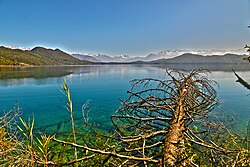|
Mugu District
Mugu District (Nepali: मुगु जिल्ला ), a part of Karnali Province, is one of the seventy-seven districts of Nepal. The district, with Gamgadhi as its district headquarters, covers an area of 3,535 km2 (1,365 sq mi) and had a population (2011) of 55,286.[1] Mugu is known for being both the most remote district in Nepal, as well as the least developed. Geography and climateMugu's geography is very rugged. The biggest lake in Nepal, Rara Lake, also known as Mahendra Daha, lies in Mugu District. It is one of the biggest districts of Nepal. Pulu is one of the more well-known villages of the Mugu district. Formerly, Pulu was a village development committee (VDC), which were local-level administrative units. In 2017, the government of Nepal restructured local government in line with the 2015 constitution and VDCs were discontinued.[2] Similarly, Seri is another prominent village of the district, which was also a VDC prior to the new arrangements for local administration. There are several other villages nearby, including Riusa, Mooh, Mangri, Serog, and Dawra.[citation needed]
TourismThe remote Mugu district is rich in natural resources. Nepal's largest Rara Lake lies in this district. Many domestic and international tourists come to visit the famous and beautiful Rara Lake. The lake is also known as the Mahendra Tal. The Lake lies at an elevation of 2,990 meters and covers about 10.8 km2 (4.2 sq mi) of area. The Rara National Park protects and surrounds it.Mugu is known as underdeveloped district of Nepal. DemographicsAt the time of the 2011 Nepal census, Mugu District had a population of 55,286. As first language, 92.4% spoke Nepali, 6.7% Tamang, 0.8% Sherpa and 0.1% other languages as their first language.[6] Ethnicity/caste: 48.9% were Chhetri, 15.4% Thakuri, 9.5% Kami, 7.9% Khampa/Tamang, 5.9% other Dalit, 5.2% Hill Brahmin, 3.2% Damai/Dholi, 1.3% Sanyasi/Dasnami, 0.9% Sarki, 0.6% Bhote, 0.3% Kumal, 0.2% Lohar, 0.2% Newar, 0.1% Badi, 0.1% other Terai and 0.2% others.[7] Religion: 91.6% were Hindu, 8.1% Buddhist, 0.2% Christian and 0.1% others.[8] Literacy: 50.8% could read and write, 4.7% could only read and 44.4% could neither read nor write.[9]
AdministrationThe district consists of four municipalities, out of which all are rural municipalities. These are as follows:[11]
Former village development committeesPrior to the restructuring of the district, Mugu District consisted of the following municipalities and village development committees:  References
29°33′N 82°10′E / 29.550°N 82.167°E Wikimedia Commons has media related to Mugu District.
|
|||||||||||||||||||||||||||||||||||||||||||||||||||||||||||||||||||||||||||||||||


